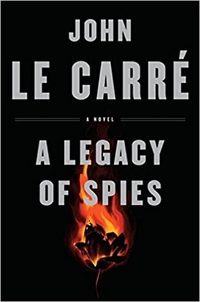
Published by Viking on September 5, 2017
John le Carré created the most extraordinary character in spy fiction when George Smiley appeared in Call for the Dead (1961). Smiley became a primary or secondary character in several other novels, including The Spy Who Came in from the Cold (1963), the novel that put John le Carré on the map. In the Karla trilogy (1974 to 1979) — the best spy novels and among the finest literary novels I’ve ever read — Smiley unmasks a mole in British intelligence. Smiley was a moral man who used immoral means to do his job well and suffered for it. Younger than Smiley but often at his side was Peter Guillam, a key player who helped Smiley gather information that exposed the double agent and brought down Karla, the mole’s handler.
John le Carré died at the end of 2020, leaving behind a legacy of brilliant spy fiction (plus a mainstream novel that I quite enjoyed). His final novel, published in 2019, was a standalone. Two years before the release of that novel, he penned the aptly titled A Legacy of Spies, the last novel in the Smiley series. In many ways, it showcases his own legacy by reaching back to the events in The Spy Who Came in from the Cold and explaining how events leading up to and following the tragedy of that novel — Alec Leamas and Liz Gold are shot at the Berlin Wall — were manipulated by Smiley and the man known only as Control.
At Smiley’s direction, Guillam has kept the true details of that incident out of the official record. Eventually the truth bites at his ankles, as Alec’s son, Cristoph, together with Liz’s daughter Karen, have sued the government, claiming that it is complicit in their parents’ deaths. Well, they’re right about that to some degree, although they don’t know all the details of Operation Windfall, conceived to smoke out the traitor in the upper ranks of the Secret Intelligence Service and to mislead Russia while protecting a vital source, an operation that had unfortunate consequences for Leamas and Gold.
Now the SIS needs to feed someone to the wolves to satisfy Parliament. Smiley is nowhere to be found. Official files have disappeared and, if they could be found, they would be covered with Guillam’s fingerprints. Guillam is politely interrogated before being locked in a library where he can read some of the secret files he hid (although not the ones he concealed off premises) as a prelude to answering more questions. Much of the novel is told in Guillam’s memory as he reads memoranda, some of which he wrote, and tries to assemble a coherent story about the past that doesn’t quite live up to the truth. As he does so, he fears that only Smiley can save him from his own indiscretions.
It put a smile on my face just to read the names of characters who have become iconic in spy fiction: Toby Esterhase, Bill Hayden, and the memorable Jim Prideaux, who makes a brief appearance near the novel’s end, quite unchanged since his featured role in The Honourable Schoolboy. And of course Smiley himself, still idealistic, still troubled by the moral choices that challenge his idealism. Looking back on his life, Smiley admits that he has never cared about preserving capitalism or Christendom. His duty was to England, not the England of Brexit but an England that was “leading Europe out of her darkness towards a new age of reason.” That England, he frets, may be moving away from reason and returning to darkness, as was much of the world when A Legacy of Spies was published.
Guillam is old as he tells this story. Unless John le Carré left a nearly finished manuscript lying about, it is his last appearance, a last glimpse of all the characters who did their best during the Cold War to lead England out of darkness. It offers the final pieces of the jigsaw puzzle that is Smiley’s career and puts a frame around the completed picture. John le Carré did his fans a huge favor, and added to an unparalleled legacy of his own, with A Legacy of Spies.
RECOMMENDED